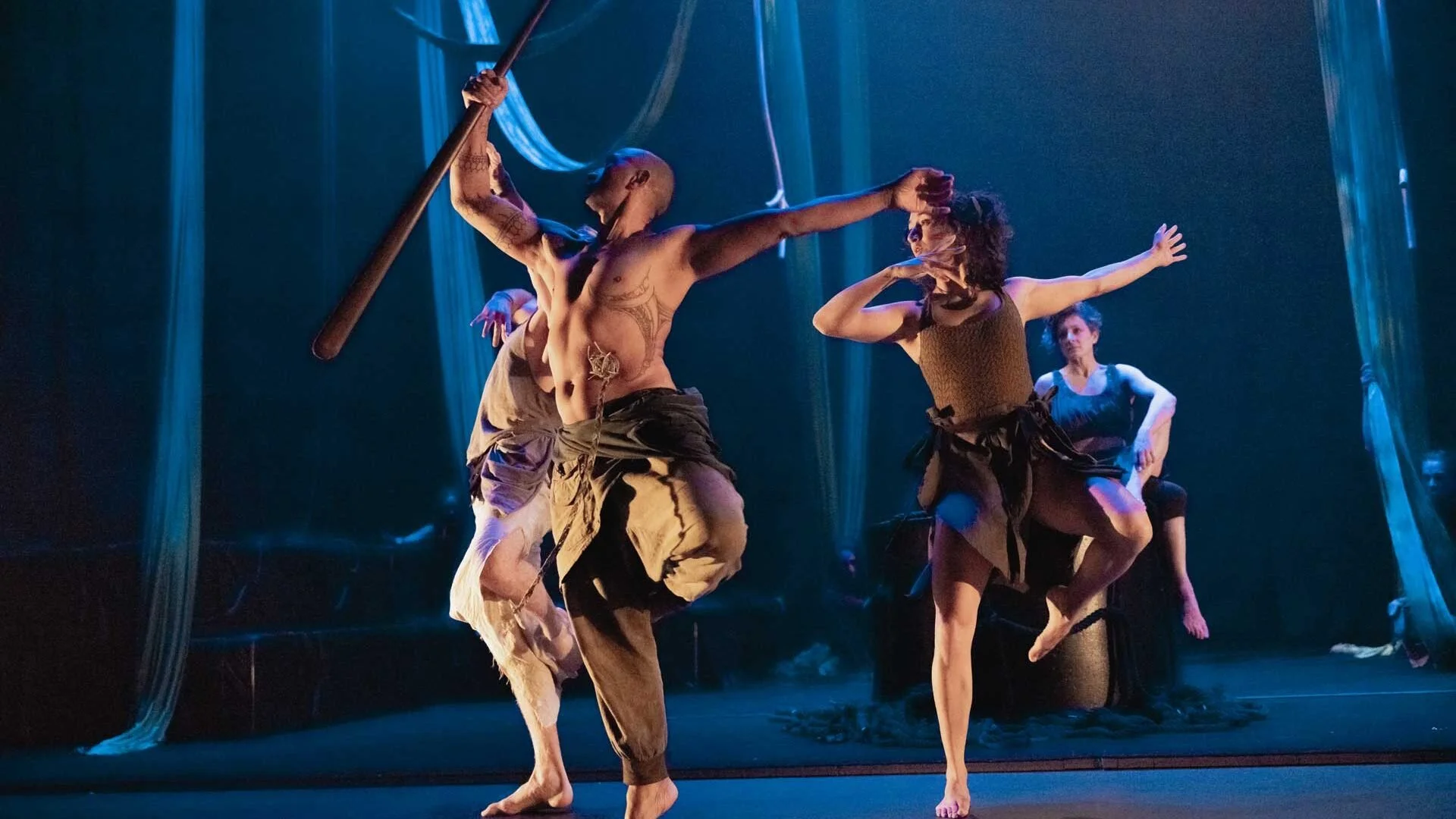Theatre review: Te Tangi a te Tūī's acrobatic stories of Māori magical spirits speak eloquently to colonial damage
Indigenous language and oral storytelling traditions drive circus-theatre piece from New Zealand, commissioned by The Cultch and Urban Ink
Te Tangi a te Tūī. Photo by LK Creative
Te Tangi a te Tūī is at the York Theatre to October 29
THE COMPLEXITIES OF reconciliation are vast. Te Tangi a te Tūī is a Māori circus-theatre piece that explores some of these intricacies in a visually and emotionally powerful presentation.
A premiere by Māori theatre company Te Rēhia Theatre and cirque-theatre company The Dust Palace—both based in Aotearoa, or New Zealand—and currently presented at the York Theatre thanks to The Cultch and Urban Ink, Te Tangi a te Tūī acknowledges Māori culture through traditional oral storytelling and expressive, physical movement. Under the direction of cowriter Tainui Tukiwaho, the show’s dramatic plot is about the scars colonialism leaves on generations of people, and the responsibilities and decisions that youth have in shaping the future.
The title of the show, Te Tangi a te Tūī (“The song of the Tui”), refers to the fact the stories we’re about to see are told through the Tūī, a songbird that soaks up the world around it and responds in song. We hear the Tūī chirping during the opening blackout, before the lights come up to reveal a serene, dream-like forest, thanks to the elegant work of set and lighting designer Jane Hakaraia. In this magical forest, Patupairehe (fairy folk)—played by world-class circus performers—fill the stage, some soaring above on silks.
When Aotahi—a young Māori woman—gives birth to a boy, Piri, a dormant curse is unlocked. Because of the actions of her ancestors, an utu (debt) must be paid to the magical beings of the forest, and only a boy from Aotahi’s bloodline can satisfy this debt. Piri is the first boy in his family’s bloodline for generations, and Aotahi tries to protect him from his fate by keeping him disguised as a girl. However, by his teen years, the magical beings have figured things out and come for him.
The magical beings out for blood are the fairy Te Pua o Te Reinga, and Koiriiri, otherwise known as the Manu (bird) who walks as a Man. Throughout the show, we see them tell their backstories to Piri. In Te Pua o Te Reinga’s case, her story is largely told through unbelievably athletic and aesthetically pleasing circus work, often involving spinning and extreme displays of flexibility on the silks, performed by both her and the other Patupairehe.
Both Te Pua o Te Reinga and Koiriiri’s stories show how their lives were damaged by colonialism, with Te Pua o Te Reinga losing her love, and Koiriiri turning from inquisitive bird to a haunted man. His dark story is primarily told through dramatic acting, and involves physical violence and dominance by a priest. Both spirits fight for Piri to take their side and serve as a vehicle for achieving self-peace.
As Piri, young Paku Fernandez delivers his character’s torn emotions especially well with his heartfelt and genuine singing near the end of the second act. This song, just like most of the dialogue in the show, is in te reo Maori (the Maori language), but Fernandez’s vocal delivery is so expressive that one doesn’t need to understand the song’s language to be moved. As his mother, Amber Curreen—who also serves as the show’s co-writer and co-producer—shows an unwavering love for her character’s son that comes across clearly through her vocal delivery and physicality onstage, regardless of language.
Acrobat extraordinaire Eve Gordon leads the company of circus performers here, playing Te Pua o Te Reinga with gravity-defying mastery, while also serving as the show’s co-creator, co-circus director (along with Geoff Gilson), and costume designer. It’s a wonder how Gordon can flip through the air on the silks using her own strength, without seeming to break a sweat, and then effortlessly delivering her dialogue and maintaining her characterization.
As Kōiriiri, Joe Dekkers-Reihana’s performance spans the spectrum of goofy and playful, to dark and disturbed. His physical agility, at first endearing as he ventures through the forest, later turns frightening as he pounces over top of the priest’s bathtub. And while his vocal delivery is at first humorous, that sense of fun is later replaced with venomous hostility.
There are many parallels to take from the stories of the magical spirits and the damage to Indigenous communities from colonialism. While the show doesn’t shy away from discussing this damage, the larger messaging here is about moving forward. Piri is symbolic of today’s youth, and the power they have to drive and change the narrative. All of this is packaged in brilliant physical artistry, and emotional vocal delivery from the cast in the Maori language. There is an English audio track available on The Cultch’s site that audiences can listen to beforehand to better understand the action and get the most out of the viewing experience. And the viewing experience is multilayered indeed—TeTangi a te Tūī is as beautiful as it is insightful, timely, and thought-provoking, in all its complexity.














